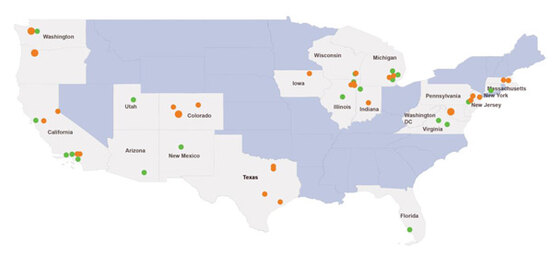Enhancing the Framework for Landscape Performance Quantification
by Yi Luo, PhD, PLA, Texas Tech University
Landscape performance is a concept that the Landscape Architecture Foundation (LAF) initiated in 2010, along with efforts to encourage the measurement and documentation of the benefits of landscape solutions in built projects. Built upon the sustainability triad, landscape performance examines environmental, economic and social aspects of sustainability. The results of these examinations can be used to reduce uncertainties and inform future design.
As part of its Landscape Performance Series, LAF has created an online database of case studies of exemplary landscape projects with quantified performance benefits. These case studies were produced primarily through LAF’s Case Study Investigation (CSI) program, which supports collaborations of faculty, students and leading practitioners. In 2012, I participated in CSI, working to document the performance of two projects in Texas and two in China.
Because landscape performance is a relatively new concept, there might be gaps in its framework, metrics and methods. As a PhD student at Texas A&M University, my dissertation research centered on studying the Landscape Performance Series to identify gaps and provide recommendations for future improvement. As of January 2014 when I conducted the study, 76 case studies had been published online, and some 29 research teams and 52 design firms had participated in CSI.

My research comprised four major steps. First, I studied how performance measurement has been used in other fields, specifically transportation, urban planning, and building performance. While landscape performance and post-occupancy evaluation of landscapes is relatively new, these other fields have been using performance metrics for decades. This comparison provides valuable recommendations for the future improvement of landscape performance, such as developing performance benchmarks for commonly-used landscape solutions, developing robust core measuring systems to facilitate efficient data collection and quantification, and developing sample questionnaires to help with social benefits quantification.
Next, I studied and compared the Landscape Performance Series Case Study Briefs published over a two year period (2011 and 2012/2013) to identify gaps, provide recommendations and reveal progress in landscape performance quantification. Aspects studied included project parameters (type, location, size, completion date), performance benefit composition and the interrelationships between environmental, economic and social benefits. The results show that environmental benefits are better documented; however, quantification of social and economic benefits is improving.
Third, considering that the quality of measurement depends largely on metrics and methods selection, I examined the currently used metrics in the Landscape Performance Series by comparing them with sustainability evaluation systems like Leadership in Energy & Environmental Desing (LEED) and the Sustainable Sites Initiative (SITES). I assessed the quality of methods by discussing their reliability and validity.
The results of these first three steps revealed that one major gap in current efforts to measure landscape performance is that cost is not fully considered. Cost is important for decision-making, with land development decision-makers often tending to prefer more profitable design solutions despite the benefits that come with sustainable solutions. So in the last step, I integrated cost into the framework of landscape performance to facilitate cost comparison and cost-effectiveness analysis of landscape solutions. I used a CSI case study – Cross Creek Ranch in Fulshear, Texas – to demonstrate cost calculation and cost-benefit analysis.

Through this study, I hope to enhance the framework of landscape performance quantification, clarify costs embedded in the benefits of sustainable landscape solutions and promote sustainable design practices.
In October, Yi Luo received her Doctor of Philosophy in Urban and Regional Sciences from Texas A&M University. She is currently an Assistant Professor in the Department of Landscape Architecture at Texas Tech University. Yi has a bachelor’s degree in architecture from Huazhong University of Science and Technology in Wuhan, China, and a master’s degree in landscape architecture from Utah State University. She has practiced architecture and landscape architecture in both China and the United States.
